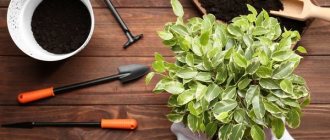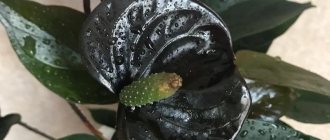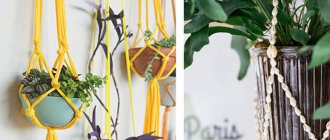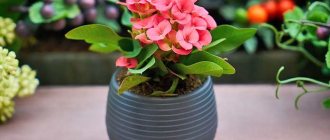What is plant stabilization? This is a technology that allows you to “preserve” a living flower by completely replacing internal plant juices with a specially developed solution that saturates all parts of the plant.
Thanks to the procedure, the flower looks completely alive, since it retains its flexibility, freshness, natural color and shape; it does not break or crumble, since it is coated with a composition that protects it from withering. The plant resembles a midge frozen in amber in its original form.
Thanks to conservation, such flower arrangements do not lose their natural appearance for almost 10 years and do not require watering, lighting, or a certain temperature regime.
Stabilized flowers appeared on the market relatively recently, although the “preservation” technology has been around for several decades.
The first research in this area began in Europe in the 1970s, and today the world leader in the production and supply of such products is the Belgian company VERMONT.
Composition of stabilized flowers
Purchasing a plant or flower arrangement “frozen in time” is not cheap, but the stabilization procedure can be done manually using glycerin. True, in this case, the color of the petals and leaves may differ from the original, and the durability is only a few months.
What is this
Stabilization is a method when plant juices are replaced with preservation solutions prepared using a special technology. They inhibit the processes of withering and cell breakdown. Glycerin, wax, and gelatin are often used to prepare solutions. However, there are other stabilization methods.
The solutions are used to saturate the entire body of the plant - stem, leaves, flowers. As a result of saturation of fabrics, texture, shape and “look” are preserved. The petals and leaves of flowers that have undergone stabilization are, as a rule, as soft and elastic as those of freshly picked counterparts.
Most often, the stabilizing solution makes the natural color and aroma of the inflorescences less bright. They are restored with the help of aromatic oils and special coloring agents.
The technology for preserving flowers, which has turned into a new trend in floristry, was developed by Jeanette and Paul Lambert, a Belgian and French woman who tied the knot. In the 70s of the 20th century, the couple moved to Kenya, where they founded their own floristic house, Vermont.
Jeannette and Paul have shortened the period of delivery of plants from the plantations to the workshops: at the initial stage, the buds that have blossomed are cut and sorted, and smooth, dense-leaved plants without flaws are selected. Then the flowers are sent to production, where workers preserve them. Specialists ensure that the technology stages are not violated.
Florists widely use preserved flowers. They decorate banquet halls, restaurants and cafes, shopping areas, hotel lobbies, etc. with them. Stabilized plants are used to create interior compositions; they look great on gift packages. Flowers that have undergone stabilization methods do not need to be watered, illuminated in a special way, or replanted.
How can you use preserved flowers?
The aesthetic appearance of cultures that have undergone glycerinization opens up wide possibilities for their use. In most cases, this is decoration, decorating a variety of spaces. Stabilized plants are widely used in the interior.
They decorate hotels, restaurants, salons. The compositions look beautiful in shop windows.
Relevant use in wedding decor.
The bride's bouquet
Embalmed flowers become a decoration for the banquet hall or space where the celebration takes place.
They are used to decorate wedding processions and tables.
The flower can be woven into the bride's hairstyle.
Stabilized plants are used to create landscape paintings, floral sculptures, and panels.
Wall composition of stabilized plants
They are suitable for vertical decoration of walls, facades, arches. Canned crops are used in landscape gardening; they are used to create various floristic forms next to open terraces. And of course, a composition of unfading flowers is an excellent gift for any occasion. Read about the use of stabilized flowers and dried flowers in the interior here.
Stabilizing flowers at home
Having mastered the skills of stabilizing flowers, you can create extraordinary bouquets with your own hands that can easily decorate your apartment, workplace, or country house. Preserved plants are suitable for gifts. Of course, today you can buy an inexpensive bouquet or a chic arrangement at any time, but no one has canceled your crazy hands... Try to make a floral present yourself.
Choose…
In addition to fresh flowers, small trees and bushes can be stabilized. They are as decorative as plants in pots, while keeping the crown dense throughout the year. Diseases and pests will bypass such flowers.
When considering which flowers to immortalize, carefully examine the leaves and stems of the candidates. These parts must be strong - the stronger, the longer the preserved plant will last without losing its original appearance. Choose flowers with thick stems and petals that can withstand the elements.
It is worth finding out in advance how well the plant tolerates stabilization. It happens that the same representative of the flora of different varieties reacts differently to the procedure. One becomes unusable already during conservation, and the second brings joy to the owner for a long, long time.
Source: m.russian.alibaba.com
Glycerin is the best way to extend the life of a plant.
Glycerin is a transparent, non-toxic, trihydric alcohol soluble in water. It is distinguished by increased hygroscopicity, that is, when in contact with air, glycerin absorbs a lot of moisture.
The substance evaporates slowly at room temperature. An aqueous solution of glycerin is used to preserve flowers. Penetrating through the stems to the plant cells, it fills them, preventing moisture from being lost.
There are two ways to preserve flowers using glycerin, which are used at home.
First way:
First you need to cut a plant whose stem length does not exceed 50 centimeters. A rose or lily would be ideal. It is necessary to keep the flower in a horizontal position for four to five hours. This is done so that the moisture evaporates. You need to make sure that the plant does not wilt. After this, glycerin is mixed with water in a one-to-one ratio and the flower stem is placed in the resulting solution. You can tint the liquid with brilliant green or food coloring to give the plant a rich shade.
It is necessary to cover the container with a cloth. Thanks to this, less liquid evaporates. Place the vessel in a dark, dry place. It is necessary to add the solution to maintain its original level and make cuts on the stem within a week, facilitating the flow of essence into the pores of the plant. You will have to wait 21 days for the flower to stabilize. At the end of the procedure, you need to take out the “preservative” and hang it vertically to dry.
The new accessory is ready! You can give it to someone as a gift, or put it on a shelf in your room. The plant kept in a glycerin solution is stored for a whole year.
In the second method of stabilization in glycerin, a solution diluted in a ratio of one to two is used. The mixture must be heated to 70°C, after which a flower with the cut end of the stem should be placed in it.
The procedure lasts two weeks, if plants with large buds are taken - three. To make the solution absorb better, you can divide the end of the stem into two halves and remove the skin from it. This stabilization method is also suitable for autumn tree branches and spruce legs.
Benefits of Glycerin:
- inflorescences and leaves retain their beauty for a long time;
- the stabilization composition does not harm the environment and the human body;
- preserved flowers are elastic, with a glossy sheen.
Disadvantages of glycerin:
- preservation lasts a long time;
- Flowers with thick stems and strong petals are suitable for the procedure;
- darkening of the petals is possible.
Tip : to keep preserved plants in their original appearance even longer, place them in a glass flask. A closed space guarantees protection from moisture and dust.
A brief excursion into history
The first to figure out how to stabilize flowers at home were Mr. and Mrs. Lambert. They worked for almost ten years to invent and improve stabilization technology. The result amazed the whole world. Thanks to the technology patented by the inventors, flower bouquets remain fresh for at least three years. How to achieve such a result?
Let's start with an analysis of the term “stabilization”. This will help us understand the essence of the procedure. Stabilization is an embalming process similar to the technology used to create mummies. During this procedure, the water contained in the stems, leaves and buds of plants is replaced with embalming fluid.
As a result of stabilization, the color and tenderness of the bouquet can be preserved for a long period of time - 3-5 years. In some cases it can be stored longer. It all depends on the chosen technology, quality of materials and plant variety.
Preserving the plant with paraffin
You can extend the life of a fragrant gift using paraffin. This plant stabilization technique is quite simple. It is enough to have cosmetic wax or an old candle on hand. For this method of preservation, it is better to choose flowers with hollow stems, or use only buds.
Paraffin must be melted in a water bath. Draw the resulting liquid into a syringe - a medical attribute in this case is used without a needle. You need to carefully inject the contents into the peduncle or stem of the plant, evenly filling the internal cavities. Upon completion of the procedure, the flower is hung upside down. In a couple of days it will dry and will delight the owner.
Benefits of paraffin:
- the technology is simple;
- After the procedure, roses, chrysanthemums, tulips, and other representatives of the flora acquire a chic appearance.
Disadvantages of paraffin : the flower does not last long. Within a couple of weeks after paraffin sprays, the leaves will turn yellow and the buds will begin to fade.
Description of the business idea and consumables
To avoid problems with the tax service, you should in any case register yourself as an individual entrepreneur. You can save on renting premises - the housewife can prepare flowers in a kitchen equipped with good ventilation.
To work you need to buy:
- flowers;
- containers;
- glycerol;
- decorations (shells, beads, sparkles, pieces of fabric, etc.)
The most expensive part of the list is flowers. In winter you can buy them in the store, in summer you can grow them in your garden. The more interesting the shape of the chosen jar, the more beautiful the product will fit into the interior of the house and the more original it will look.
The costs of starting a business are minimal. There is no need to rent premises, hire workers, or waste free time. Sales are carried out offline or via the Internet.
You can sell products through an intermediary: for example, if there are special portals for handicrafts or organizations in cities that allow you to sell goods of your own production. Naturally, they take a certain percentage of sales for the work. But in this case, the needlewoman is freed from worries about organizing and finding clients.
Beeswax - assistant to flower longevity
Another simple technology is stabilizing the flower with beeswax. Just as in the first case, we drown the waste product of bees in a water bath, and, without allowing the substance to harden, we immerse the plant in it.
For the procedure to be successful, it is necessary to distribute the wax evenly throughout the flower. To do this, you need to twist the stem around its axis. After treatment, the plant should be hung upside down and wait until the beeswax hardens.
Benefits of Beeswax:
- fast way and excellent results. After being treated with beeswax, the flower will not only delight you with its natural shade, but also with additional shine;
- You can easily brush off the dust covering the leaves.
Disadvantages of Beeswax:
- A week will pass, and the plant will begin to fade - fade and turn yellow, the leaves will become heavier;
- flowers treated with beeswax are sensitive to the sun.
Source: pixabay.com
Basic methods of stabilization
The methods available for home embalming are not as complicated as they may seem at first glance. Despite the fact that stabilizing flowers is a long process, it is worth admiring them for a long time. This is a great way to preserve a memorable bouquet given on a first date for the coming months, or to prepare a gift for a loved one in advance.
Impatient florists can use some tricks, then the process of making flowers in glycerin or liquid wax will be shortened by several days or weeks. Each method has its own characteristics, so you need to study them in detail.
In glycerin
A preservative composition is a substance that can nourish the cells of a plant, preventing it from withering. This is the basis for the method in which glycerin is used for flowers during the embalming process.
- Prepare a solution of equal parts water and preservative.
- Cut the plant from the flowerbed or re-cut it if the flower was brought from the store.
- Pour the solution into a vase and place the flower in it so that most of the stem is immersed in the liquid.
- Every day, take out a sample and cut off a half-centimeter fragment of the stem.
- After a week, completely replace the composition and immerse the plant in it.
The flower itself will let you know that the canning process is complete. Droplets of moisture will appear on its leaves and petals; you can hang the plant with the bud down for a week or two, and then use it in compositions.
An article about what plants and flowers are used to make bouquets and compositions.
Preserving roses in glycerin
In paraffin
Alas, specimens with small buds or very thin, miniature petals are not suitable for this method.
Most often it is used for roses with expressive large buds. The step-by-step process looks like this:
- take candle wax or liquid paraffin, pour into a container and place in a water bath;
- the substance will heat up, become transparent and warm, if it is very hot, cool slightly;
- take the flower by the stem and dip it in the preservative, carefully turn and remove;
- lift it slightly so that the bud looks up - this will allow the paraffin to flow inside it;
- with a break of 1-2 minutes, continue “bathing” the bud.
After completing the procedure 3-5 times, hang the plant by the trunk with the bud down - let the excess wax drain. It will seal each petal with the thinnest layer, blocking the access of air and bacteria to preserve its pristine beauty and fresh appearance.
How to preserve flowers with wax
This is not a very popular method even among professionals, since it does not apply to all plants, but only to those that have an empty stem. Its space must be filled with paraffin. To do this, use a syringe several times, plunging it into the hole at the base of the stem. Ideally, paraffin should fill all plant tissues, but it is quite difficult to verify the quality of the filling.
Hair fixation spray
The peculiarity of this method is that the buds do not retain their spectacular appearance for as long as when stabilized with glycerin or paraffin. But they will still be able to extend their life for a while.
- The bouquet needs to be disassembled into individual flowers.
- Each sample is sprayed with hairspray at a distance of 30-35 cm.
- The stems, almost to the buds, are immersed in silicate gel; it can be replaced with semolina or dry sand. These products will quickly absorb moisture from the plant.
- After 7-10 days, the flowers are removed, cleaned and the buds are varnished again.
Try using glitter or colored polish to make the shades unusual and original.
Preservation with hairspray
This is the most affordable way to stabilize a plant. Hairspray can be found in the cabinet of any representative of the fairer sex. It’s good if the curl styling product has a strong hold, although other types are also suitable.
Before you start preserving, you need to dry the flower, especially if we are talking about a freshly cut plant. To do this, you can put it in a container with an airtight lid for several days. Dry moss or activated carbon are placed at the bottom of the container; silica gel or sand are also suitable. When the flower is ready for the procedure, you just need to treat it with varnish, and then make sure that the substance spreads evenly on the petals, stem and leaves.
At the end of spraying, the plant must be dried, placing the bud down and leaving it in this state for a week. In seven days the handsome man will be ready. You can safely use it in decor.
Advantages of varnish conservation:
- simplicity, accessibility;
- the technology does not require special skills and does not take much time.
Disadvantages of varnish conservation:
- within a couple of days the flower will begin to lose its attractive appearance and natural flexibility. The plant will become fragile. It can easily be damaged by accidentally touching a leaf, so it is extremely difficult to sweep away dust from such an object;
- Over time, dark spots will appear on the petals and other parts - a consequence of chemical treatment.
How to register a business and how much you can earn
To open a business for making flowers in glycerin, register as an individual entrepreneur (IP) or self-employed if your annual income does not exceed 2.4 million rubles. Larger forms of organization in this business are impractical.
When registering an individual entrepreneur, indicate the OKVED code - 52.48, which relates to the production of souvenirs, or 32.99 - the production of other finished products.
Many entrepreneurs choose a simplified taxation system (6%), in which tax is calculated based on the income received. Self-employed people pay 4% when working with individuals.
Let's calculate the profitability of the business. For example, let's take a small workshop organized at home. To open you will need to spend:
| Expense item | Amount (rub.) |
| Registration of business (IP) | 800 |
| Flowers | 1 000 — 5 000 |
| Containers, decor | 5 000 |
| Glycerol | 1 000 |
| Total: | 7 800 – 11 800 |
On average, 150 rubles are spent on the production of a unit of goods. When selling retail through your website or social media account, the profit from one composition is 850 rubles.
Attention! By selling 50 units per month, you will make a profit of 42,500 rubles.
Composition in a glass vessel
An excellent method that is suitable for preserving both individual flowers and compositions or small bushes. Bouquets in an original transparent glass jar can decorate your home or be a good birthday gift. Hand-made is in fashion now!
Before you start canning, you need to sterilize the vessel where the plants will “live”. The jar should be held over steam for several minutes or doused with boiling water. This procedure is mandatory; it helps get rid of germs.
When the vessel is ready, you need to place the plants in it, forming a composition. Fantasy will come to the rescue. You can add twigs with openwork leaves or greenery to the flowers. Pebbles, shells, and beads are suitable as decoration - the main thing is that these small things are resistant to moisture.
Having laid out the composition, the jar is filled with solution. There are several recipes.
First . For preparation you will need glycerin. The substance must be diluted in a ratio of one to two - part glycerin to two parts drinking water. Pour the solution into a jar. After two days it needs to be changed.
Second . It is prepared as follows: sugar and gelatin are dissolved in equal proportions in water, and then left for several hours. Then the composition is heated on the stove, mixed well, and then filtered through cheesecloth and a fine sieve, getting rid of particles that have not dissolved.
Third . A saturated saline solution is also suitable for preserving flowers in a jar.
No matter what composition you choose, do not forget to distribute the flowers harmoniously so that the composition looks neat. When drowning in liquid, plants should not come into contact with each other. Close the container with a lid. It can be decorated with ribbon or twine. The composition is ready!
Advantages of canning:
- bouquets in jars look very advantageous and original;
- plants floating in the solution retain an attractive appearance for a long time;
- conservation technology is simple and does not take much time.
Disadvantages of jar preservation : flowers can only be seen through the glass of the vessel; plants cannot be taken out.
Various design options for stabilized colors
Bride's bouquet of preserved flowers
Arrangement of stabilized roses
Once you learn how to stabilize flowers, you will realize what a magical material is in your hands. No artificial plants, even the best-made ones, can compete with live embalmed plants.
They retain their tenderness, natural characteristics and allow them to be used to create truly masterpiece compositions.
Compositions of stabilized flowers in a jar with glycerin are very popular. The solution is prepared from two parts water and one part preservative. Herbs, leaves, plants, moss are immersed in liquid and kept for 2 weeks with constant renewal of the solution or the addition of glycerin.
For faster stabilization, it is advisable to close the container with an airtight lid. The final stage is creating the composition and pouring fresh solution. The jar is sealed and the outside is decorated with ribbons, beads, and other decorative elements.
Stabilized flowers in a flask are a trend in commercial floristry.
Gift packaging “Rose in a flask”
Such decorations are expensive, but they can be made at home. A flask with a wooden base can be purchased at art and craft stores. The rose placed on the stand is secured with a nail or superglue - the elegant decoration is ready.
Wreaths made from stabilized plants will help create a festive atmosphere in any interior. You can use not only flowering specimens, but also herbs, moss, and twigs.
The use of stabilized moss in the interior
Stabilized moss in apartment design
Stabilization of moss is possible only in a glycerin solution; it is fragile, but wax still makes it heavier.
Professionals create entire paintings from stabilized colors. Like an artist’s canvas, they do not lose the brightness of their colors for a long time, look beautiful, and become an interior decoration for a long time. But in order to make a picture, you need not one flower, but several plants, preferably even different types. After going through the embalming procedure, they are glued to a cardboard base and framed into a baguette.
Read about what types of flowers are used for bouquets and what they symbolize here.
How long does a stabilized plant live?
How long the flower will retain its attractive appearance depends on the preservation method. Care also plays an important role. If a stabilized plant is kept in a glass flask, it will last up to ten years, and without such protection no more than two.
Plants that have undergone the conservation procedure do not require special care. The main thing is to keep them out of the sun, make sure they don’t get wet, and treat them from dust with a soft sponge or hairdryer, setting the device to a cold air flow. The product should be kept away from fire as it is easily flammable.
If the flowers are placed in a glass flask, then you can treat the outside with window cleaner. An unprotected plant should be kept in a room with a humidity of 60-80%. At lower humidity, the flowers will become brittle; at high humidity, they will absorb a lot of water and deteriorate. The temperature in the room where the flowers are located should not be lower than +5 degrees, but not higher than +35.
Stabilized flowers are no different from live ones. They will decorate your home or office, and are also suitable for decorating a holiday table. There are many conservation technologies. With the help of any, you can create an original composition, and if you follow simple rules of care, you can enjoy it for many years.
If something went wrong during the stabilization process, no problem! You can please yourself, family and friends with fresh flowers at any time, for example, by ordering delivery from the Russian Bouquet company.
Preserving flowers in special alcohol mixtures
Remember at the very beginning of the article that we said that the composition invented by the Lamberts was patented and kept secret? So, you can buy it online from dealer companies. The online stores of such companies usually describe in detail how to make stabilized flowers at home or industrially. As in the case of glycerin, two methods are offered:
- Soaking freshly cut plants and then dyeing them;
- Watering the bushes with embalming mixture instead of water.
This method is not particularly popular, since the cost of such mixtures is quite high. They are usually used by designers to create expensive floral arrangements.
Rose in glycerin
You may be interested in: How to make money making handmade jewelry. TOP 10 ways to promote
Rose is one of the most beautiful and popular flowers, a symbol of passionate and ardent love. After the procedure of preservation in glycerin, the rose retains its pristine beauty for several years. This is a wonderful gift for any occasion.
To preserve roses, it is important to choose a container so that the petals do not get wrinkled: a bottle, glass or small aquarium. But the “rose under a hood” is especially popular. After treatment in glycerin, the flower is fixed on a stand and covered with a glass dome. Additionally, the rose is decorated with decorations, and the fallen petals are embalmed and laid out as decoration.
Benefits of use
Although such crafts are not yet very popular in our country, stabilization technology is very popular in Europe. It is used in the design of banquet halls and shop windows, plants are put on public display in business centers and spas, and used in landscape designs and apartment interiors.
Advantages of stabilized plants:
- Long term. By applying the technique to a whole bouquet, it is possible to extend its life by six months, to a single flower - up to 3-5 years, to a shrub - up to 7, trees - up to 10 years, mosses - up to 40.
- Preservation of the natural picturesque appearance inherent in a living plant.
- Low maintenance, out of season.
- Harmlessness – the technology does not pose any danger to the health of owners and pets.
- Versatility in use. You can revive not only your home with stabilized plants, but also other rooms where there are a lot of people.
One of the advantages of such flower arrangements is durability.
Recommendations from experienced flower growers
Perennial flowers from A to Z
White flowers are best suited for coloring. The glycerin composition will fill all the veins, and it will be most noticeable and beautiful on the white buds.
On a note! Stabilized roses do not need to be placed in water. You can put it in a pot with dry sand. No watering is required, you just need to carefully wipe off the dust from time to time. If handled carefully, the flower will last quite a long time.
Stabilized flowers bring joy for a long time. Perhaps it will be a purchased plant. A stabilized flower created with your own hands will bring even more joy and pride.
*Prices are current as of September 2022.
0 0 votes
Article rating
Not only flowers suit us...
Another common preservation material is moss. It is prepared only by immersion, repeatedly washing and changing the solution. To achieve a decorative effect, dyes are added: green, emerald, grass, yellow, ocher and others.
Moss lends itself well to coloring.
And if you show your imagination, you can create a whole picture from preserved plants.
Moss is suitable for creating phytopictures from stabilized plants.
Not only flowers are used to create decorative panels. In skillful hands, individual leaves come to life and are woven into fabulous pictures.
The painted leaves fascinate with their fabulous designs.
The principle of canning is similar to flowers: you can put large leaves with long stems in a glass with a solution, and put small ones in a flat plate, you just need to lightly press down on top with a weight so that they are completely covered.
Immerse the leaves in the solution and let them soak for a week.
It is best to paint leaves with oil or acrylic paints, and you can add spectacular accents with glitter or contours for working on glass.
Whole branches can also be preserved vertically. Just to create compositions you will need tall vases:
Spectacular flowerpots and candlesticks.
These preserved twigs are perfect for decorating a rustic room. The containers in the form of a jar look as if they accidentally came to hand when the hostess was looking for a candlestick.
Such a cute detail will add ease to the interior.
Glycerin cost
Glycerin is the main component of the preservation solution. In essence, it is one of the forms of polyhydric alcohol, in the form of a transparent viscous liquid.
The cost of glycerin depends on the volume. The larger the volume, the lower the price per 1 liter. However, you should not purchase glycerin in large quantities at the beginning of your activity. A 1 liter bottle will be enough. The approximate cost of glycerin is shown in the table.
| Volume | Cost, rub.) |
| 25 gr. | 23 |
| 40 gr. | 38 |
| 1 l. | 210 |
| 10 l. | 1.400 |
| 20 l. | 2.200 |
| 28 l. | 2.600 |
The concentration of glycerin, which is sold in pharmacies, is 90%. The glycerin content in large containers is 99%. Therefore, more water is required when diluting. When preparing the solution, it is important to follow safety rules and work only with rubber gloves.











